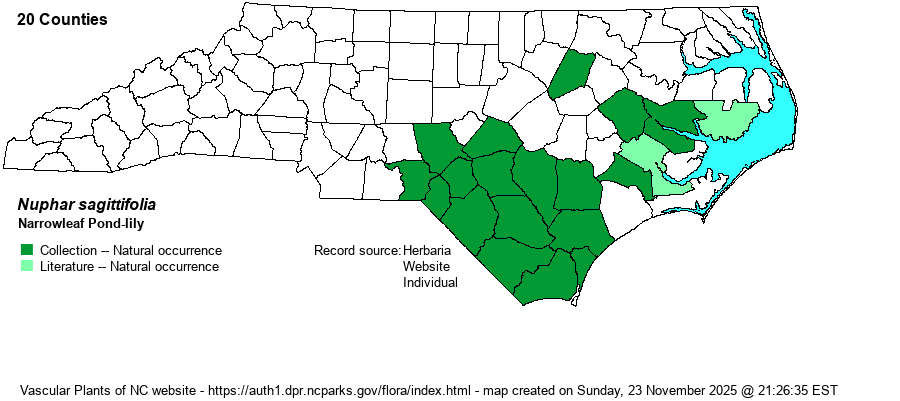| Author | (Walter) Pursh | |
| Distribution | Throughout the southern Coastal Plain, including the Sandhills region. Scattered in the central portion of the Coastal Plain, but no records yet north of Nash, Pitt, and Beaufort counties.
This species has a small range: rarely in eastern VA, then south to northeastern SC. | |
| Abundance | Possibly declining in the state, and thus there is some concern for its global population; a Federal status review or survey is currently in progress. Still locally common along some blackwater rivers and lakes in the southern part of the range. Uncommon and local in the central portions of the Coastal Plain. Some populations seem to be intermediate in leaf shape and suggest hybridization with N. advena. The NCNHP considers this taxon as a Watch List species, but moved the State Rank in 2021 from S2 downward to a more numerous S3. | |
| Habitat | This species generally requires blackwater conditions, though it does occur in the more neutral pH Lake Waccamaw. It favors acidic rivers and streams, as well as lakes and impoundment ponds; both in still water as well as in moderately flowing water. | |
| Phenology | Blooms from April into October, and fruits within this same period. | |
| Identification | This aquatic species essentially has all of its emergent leaves floating on the water surface, as opposed to mostly raised above the surface in the very similar N. advena. (Both species have linear submerged leaves.) Most populations can be easily told from N. advena by not only all leaves floating at the surface, but also by the narrow leaves, in N. sagittifolia being more than 3 times as long as wide, and normally 5-6 times length to width. Thus, the leaf blade can be 10-12 inches long and only 3-4 inches wide. However, some populations, especially in the Sandhills, have this ratio more like 3:1 length to width, leaning to typical sagittifolia (and generally considered to be this because the leaves are all floating and because the occurrence is on black water). Note also the occurrence of underwater, lax, pale green, "lettuce-like" leaves; absent in Broadleaf Pond-lily. The flowers are very similar to those of N. advena, being a yellow ball about 1-2 inches across, with the many petals only partly spreading in age, and raised just a few inches out of the water. This is a familiar taxon to biologists who canoe or kayak on blackwater rivers such as the Waccamaw, Black, and Northeast Cape Fear rivers. However, populations are diminishing, perhaps as sea level rise and salt water intrusion into the lower portions of some of these rivers is killing the plants. Whether mixing of genes through introgression/hybridization is increasing is not certain, though this seems to be a growing concern. | |
| Taxonomic Comments | Many references consider this as a variety or subspecies of Nuphar advena, in part owing to its small range, wholly within the range of the widespread species, and the intermediate nature of some populations. NatureServe names it as Nuphar lutea ssp. sagittifolia, with a Global Rank of G5T2 (meaning the full species -- N. lutea -- is globally secure but the subspecies is quite imperiled. [A subspecies designation is incorrect, as subspecies must have allopatric ranges, not overlapping ones; a variety is the correct designation for two taxa with overlapping geographic ranges.] However, Weakley (2018) argues that because both species occur over the same range, with N. advena mainly in the richer sediments and brownwater areas and N. sagittifolia more in the acidic, blackwater areas, there is no intermixing of genes in most populations in the overlapping counties. This website follows Weakley and trests it as a good species, though with the Global Rank being changed to [G2].
| |
| Other Common Name(s) | Cape Fear Spatterdock, Arrowleaf Pond-lily. Note that names such as Yellow Pond-lily or Cow-lily can refer to both of the NC species in this genus. | |
| State Rank | S3 | |
| Global Rank | G5T2 [G2] | |
| State Status | W1 | |
| US Status | | |
| USACE-agcp | OBL link |
| USACE-emp | OBL link |

